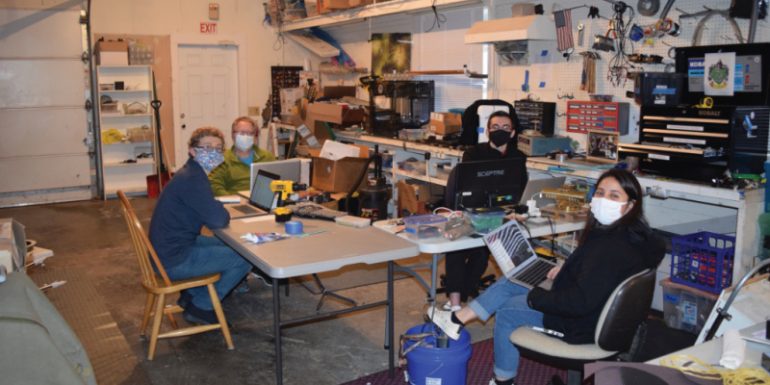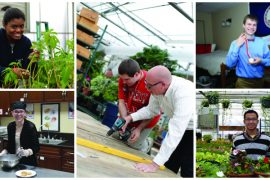By Amanda N. Wegner
Many of us have fond memories of running through soft grass on balmy summer nights, Mason jar in hand, capturing fireflies and reveling at their glow. However, the increase of nighttime lights across the globe, which creates light pollution, is putting a damper on that long-held tradition.
To counter this, a local organization — GLAS Education, which spun out of Yerkes Observatory when it closed in 2018 — is working to darken the night sky, and they’re starting their journey with innovation and data. Formed as a nonprofit by former Yerkes employees to keep the observatory’s projects and outreach alive in the area, GLAS Education provides inclusive STEAM (science-technology-engineering-art- mathematics) programs that support the local and global good.
Last November, staff, students and volunteers from GLAS Education launched a test run of its student-built light pollution sensor as part of the LENSS (Lakeshore Environment and Night Sky Sensor) project. The sensor is the first of what the group hopes will be one of many that quantify how much light is filling the night sky — and eventually turns the dimmer on light pollution — in the Geneva Lakes area.
THE PROBLEM WITH LIGHT POLLUTION
Adam McCulloch understands that for some, light pollution sounds silly. “It’s not like air pollution or water pollution, where there’s bad stuff in the air or water and people want to know about it,” says McCulloch, planetarium specialist for GLAS Education.
Light pollution is defined by the inappropriate or excessive use of artificial light. In the last century, we’ve gone from seeing twinkling stars to a general lightness and glow with the increase in streetlights, landscape lights, exterior house lights and the like. In short, our penchant for more light has polluted the night sky, and this excess light has consequences on the environment and our health.
“It affects many things,” says McCulloch. For instances, he explains that fish, insect and amphibian hatchlings are drastically impacted by light pollution as it affects their growth rates. Light pollution is a leading threat to fireflies; they use their glow to attract mates, and excessive nighttime light makes it hard for them to see one another’s luminescent mating calls. For birds that migrate at night, such as songbirds that use moonlight and starlight to drive their course, light pollution can disorient them or send them fatally careening into buildings, much like a moth to a flame.
For humans, many nighttime lights emit blue spectrum light, which can throw off our circadian rhythm.
“It’s much like how they say to not look at your phone or TV an hour before bed,” explains McCulloch. “Devices give off a lot of blue light, which tells our brains that it’s still day.”
If our brains think it’s daytime, they don’t produce melatonin, the hormone that regulates the wake-sleep cycle. Research has also shown that reduced levels of melatonin may increase the incidence of certain cancers, and higher rates of cancers have been linked to areas with more light pollution.
To be clear, the push for darker skies isn’t about eliminating all nighttime light. “There is a need for light at night in modern times. The common misconception is we want to go back to the 1500s and have no light,” explains McCulloch. “What we want is light that is necessary, directed down to illuminate what it is meant to illuminate.”
For instance, he says, a bright, unshielded light on your neighbor’s home can cause glare and actually decrease your vision at night by dilating your eyes. Motion- activated lights focused on key areas are much more effective and friendly to the sky. In addition, moving away from blue- spectrum lights to those that are more in the red part of the spectrum is also beneficial.
DATA FOR DARKER SKIES
The LENSS project was launched in 2019 and grew from the desire of GLAS Education staff to create a student project that benefits the community while providing hands-on STEAM experience. Working with professionals in engineering, project management, coding and design, students, with assistance from adult volunteers, were tasked with designing, constructing and testing a remote-operated sensor that could monitor sky quality around Geneva Lake to support the Geneva Lake Dark Sky (GLDS) initiative. Formed in summer 2015, GLDS is a community- wide movement to see the stars again by raising awareness about light pollution in the Geneva Lake area and ultimately designating Geneva Lake as a dark sky haven.
“Young people are amazing,” says Chris Kirby, GLAS Education volunteer. “They are full of ideas, energy and enthusiasm. This LENSS project gives our students a wonderful opportunity to deploy their many talents and skills to make a difference within our community.”
Students involved with the project have also gained other experience as well, such as researching scientific articles on light pollution and its effects; creating social media posts for the project; and creating informational pieces for homeowners and the community.
“To be part of this project for the past year and see how far we’ve come is a tremendous honor,” says Melynna Arreola-Quiroga, a student volunteer who worked on public outreach. “What makes our LENSS deployments and outreach material even more exciting is that they will be accessible by Spanish-speaking members of our community. In order for our community to thrive, we must strive to offer educational material for people of all backgrounds, and here at GLAS Education, we are trying our best to ensure better livelihoods for people of all backgrounds.”
Last November, the first sensor was installed on private property in Fontana. The sensor takes continuous measurements of how dark the skies are around Geneva Lake. The sensor itself sits in a small, approximately 3-by-5- inch box and has a lens that scans a 60-degree arc of the sky. Data from the sensor is automatically sent back to GLAS Education.
The test period will validate the sensor’s functionally and ensure it can withstand a Wisconsin winter. The plan is to have students continue to tweak the design and add sensors on the southern and eastern shores of Geneva Lake, says McCulloch.
Thelong-termvisionistoeventuallyhave a network of sensors around the lake and use the data to inform changes to local ordinances that support the Dark Sky initiative. The data would also validate the impact of those changes.
“It was a long process getting to the point of finally being able to deploy our first sensor on November 17 and the shared feeling of pride and accomplishment was truly awesome and satisfying, but the first sensor is just the first step,” says student volunteer Jack Adams. “We will continue to raise awareness of the impact of light pollution in our area and the importance of the LENSS project with the hope of encompassing the lake with sensors that will collect valuable data.”
SUPPORTING THE CAUSE
The best way to change people’s perceptions on light pollution, says McCulloch, is to get everyone involved. “We really want to make this a community effort,” he says.
GLAS Education is always looking for people who have skills they are willing to share with the organization and more volunteers to help with outreach. They also welcome homeowners and landowners along the lake or near the lakeshore who are willing to offer a power source and Wi-Fi to host a sensor.
To learn more about LENSS and how you can be involved, visit glaseducation.org/lens-sensor.
As part of GLAS Education’s inclusive mission, all programs are free, so donations are key to its success. “Financial support is always welcome, especially if you’d like to see the LENSS project continue to grow, if you want to help support student projects and local STEAM education, if you want to help us keep going,” says McCulloch.





